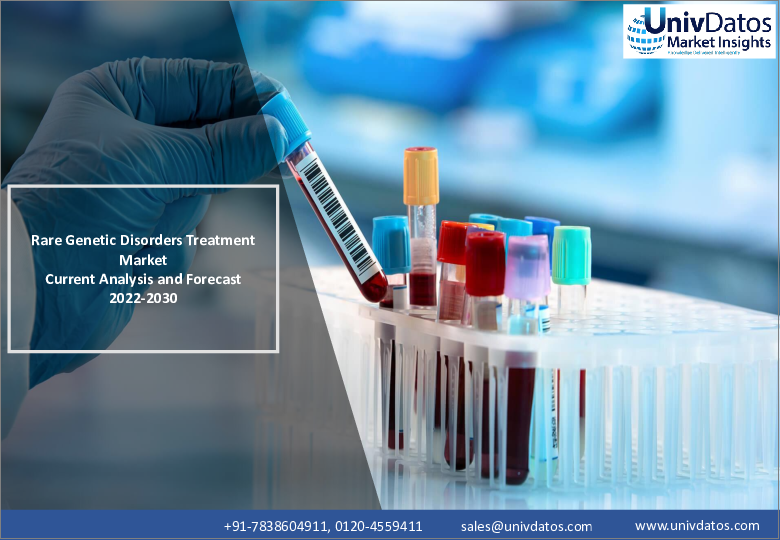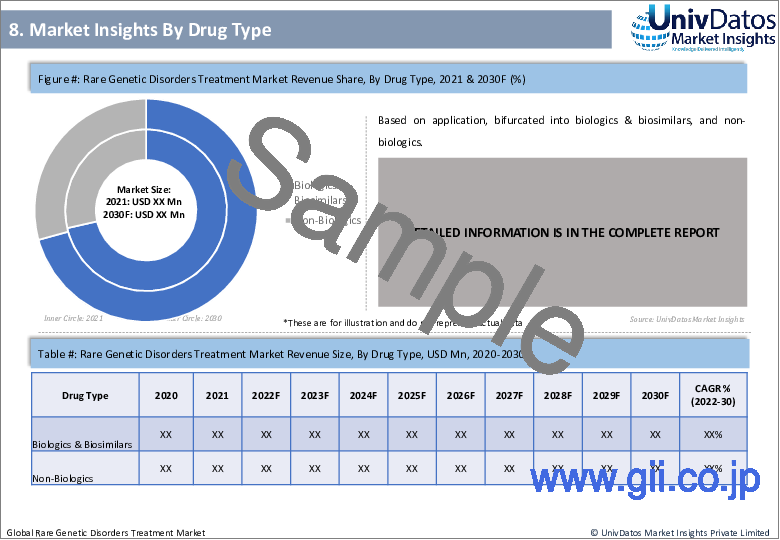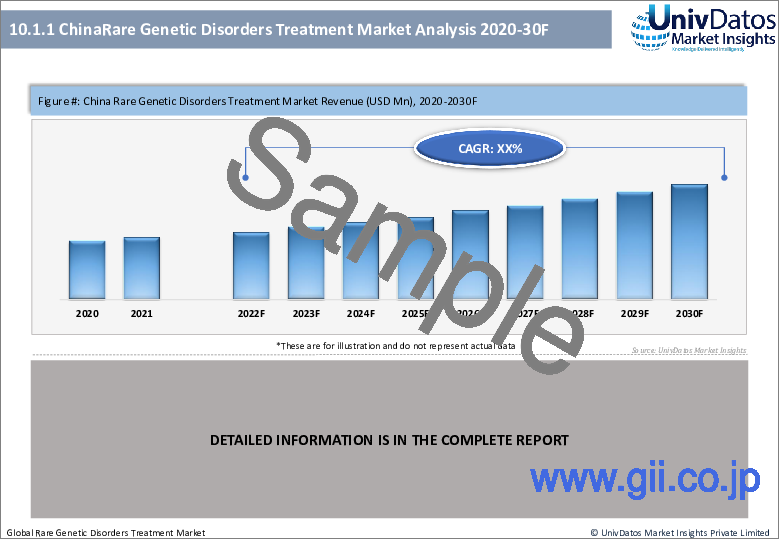|
|
市場調査レポート
商品コード
1290876
希少遺伝性疾患治療市場:現状分析と予測(2022-2028年)Rare Genetic Disorders Treatment Market: Current Analysis and Forecast (2022-2028) |
||||||
|
● お客様のご希望に応じて、既存データの加工や未掲載情報(例:国別セグメント)の追加などの対応が可能です。 詳細はお問い合わせください。 |
|||||||
| 希少遺伝性疾患治療市場:現状分析と予測(2022-2028年) |
|
出版日: 2023年04月01日
発行: UnivDatos Market Insights Pvt Ltd
ページ情報: 英文 147 Pages
納期: 即日から翌営業日
|
- 全表示
- 概要
- 目次
希少遺伝性疾患治療市場は、希少遺伝性疾患の増加により、予測期間中に11.9%という高いCAGRで成長すると予想されています。世界的に希少遺伝性疾患の発生率は著しく増加しています。2022年5月のGARD(Genetic and Rare Diseases)情報センターによると、アメリカ人の10人に1人(3,000万人)が希少疾患を抱えており、約7000の希少疾患が知られています。さらに、「GlobalGenes」が2021年9月に更新したデータでは、世界で4億人以上の人々が希少疾患の影響を受けているとされています。希少疾患の80%は、遺伝的な起源を持つことが確認されています。
用途に基づき、市場は、がん、神経疾患、心血管疾患、代謝疾患、血液疾患、その他に区分されます。主に、希少遺伝性がんの発生率の急増と、その早期診断のためのゲノムシーケンス技術の進歩により、2021年にはがん分野が市場の圧倒的シェアを占めています。これに加えて、複数の製薬企業が新薬候補を特定するための研究開発に積極的に投資しているため、今後数年間のセグメント成長に好影響を与えています。例えば、2022年11月、Unravel Biosciencesは、希少がんの治療標的を発見するためにSpaniosと提携を締結しました。この提携により、Unravel Biosciencesは、同社の人工知能(AI)遺伝子ネットワークベースの計算モデルを活用し、トランスクリプトーム情報に応じて治療化合物や基礎となる新規標的を予測する予定です。
薬剤の種類別に見ると、市場は生物学的製剤およびバイオシミラーと非生物学的製剤に二分されます。生物学的製剤&バイオシミラー分野は、疾患に対する特異性が高いことから、2021年には市場の圧倒的シェアを占めています。生物学的製剤&バイオシミラー医薬品は、血液疾患を含む希少な遺伝性疾患の治療に使用されることが多くなっています。生物製剤とは、生きた細胞に由来する医薬品であり、タンパク質、抗体、その他の複雑な分子が含まれます。バイオシミラーは生物学的製剤と似ていますが、生物学的製剤の特許が切れた後に開発されたものです。リツキシマブ、アダリムマブ、ジンテグロなど、いくつかの生物学的製剤が希少遺伝性疾患の治療薬として承認されました。これとは別に、製品パイプラインの増加や臨床試験での有望な反応も、このセグメントの将来的な成長を示唆しています。例えば、2020年にRegenreon Pharmaceuticals社は、進行性骨化性線維異形成症(FOP)患者を対象にガレトスマブ(REGN2477)を評価する44人の患者を対象とした第2相二重盲検プラセボ対照試験LUMINA-1から心強い結果を発表しました。
市場は、販売チャネル別に、病院薬局、オンライン薬局、小売薬局に区分されます。オンライン薬局は、予測期間中に高いCAGRを記録すると予想されています。オンライン薬局は、その利便性の高さから、市場でも大きな勢いを見せています。消費者は自宅に居ながらにして薬を注文し、玄関先まで直接届けることができます。これは、地方に住んでいる人や移動に問題がある人にとって特に有益で、実店舗の薬局に行く必要がなくなるからです。さらに、オンライン薬局は、諸経費が少ないため、従来の実店舗の薬局よりも低価格で提供されていることが多いです。さらに、オンライン薬局は、顧客を引き付け、維持するために、割引、プロモーション、ロイヤルティプログラムを提供することがあります。全米地域薬剤師会が実施した調査によると、回答者の61%が、オンライン薬局の利用を選択した主な理由はコストであると回答しています。
希少遺伝性疾患治療業界の市場導入に関する理解を深めるため、北米(米国、カナダ、その他北米地域)、欧州(ドイツ、英国、フランス、スペイン、イタリア、その他欧州地域)、アジア太平洋(中国、日本、インド、その他アジア太平洋地域)、その他世界の国々における、世界規模をベースに市場を分析しています。アジア太平洋市場は、希少疾病に対する意識の高まり、医療費の増加、政府の好意的な政策により、予測期間中に最も高い成長率を記録すると予想されます。さらに、同地域における希少疾病の発生率の上昇や治療薬の充実も、市場の成長を後押ししています。例えば、世界経済フォーラムによると、アジア太平洋地域では約2億人が希少疾病に罹患しているとされています。
目次
第1章 市場イントロダクション
- 市場の定義
- 主な目的
- ステークホルダー
- 制限事項
第2章 調査手法または前提
- 調査プロセス
- 調査手法
- 回答者プロファイル
第3章 市場要約
第4章 エグゼクティブサマリー
第5章 世界の希少遺伝性疾患治療市場、新型コロナウイルス感染症(COVID-19)の影響
第6章 世界の希少遺伝性疾患治療の市場収益、2019-2027年
第7章 市場洞察:用途別
- がん
- 神経学的障害
- 心血管疾患
- 代謝障害
- 血液疾患
- その他
第8章 市場洞察:薬剤の種類別
- 生物製剤およびバイオシミラー
- 非生物製剤
第9章 市場洞察:流通チャネル別
- 病院薬局
- オンライン薬局
- 小売薬局
第10章 市場洞察:地域別
- 北米
- 米国
- カナダ
- その他北米地域
- 欧州
- ドイツ
- フランス
- 英国
- イタリア
- スペイン
- その他欧州地域
- アジア太平洋
- 中国
- 日本
- インド
- その他アジア太平洋地域
- 世界のその他の地域
第11章 希少遺伝性疾患治療市場力学
- 市場促進要因
- 市場の課題
- 影響分析
第12章 希少遺伝性疾患治療市場機会
第13章 希少遺伝性疾患治療市場動向
第14章 需要側と供給側の分析
- 需要側分析
- 供給側分析
第15章 バリューチェーン分析
第16章 価格分析
第17章 競合シナリオ
- ポーターのファイブフォース分析
- 競合情勢
第18章 企業プロファイル
- F. Hoffmann-La Roche Ltd.
- Pfizer, Inc.
- AstraZeneca
- Bristol Myers Squibb
- Takeda Pharmaceutical Company Limited
- Novartis AG
- AbbVie Inc.
- GlaxoSmithKline Plc
- Amgen Inc.
- Johnson & Johnson Inc.
第19章 免責事項
Rare genetic disorders, also known as orphan diseases, are defined as conditions that affect fewer than 200,000 people in the United States or fewer than 5 in 10,000 people in the European Union. While these diseases are individually rare, collectively they affect millions of people worldwide. The orphan drug market has been driven by government incentives, such as expedited regulatory review and approval processes, tax credits, and extended periods of market exclusivity.
The Rare Genetic Disorders Treatment Market is expected to grow at a strong CAGR of 11.9% during the forecast period owing to the rise in the incidences of rare genetic diseases. Globally the incidence of rare genetic diseases is increasing tremendously. According to the Genetic and Rare Diseases (GARD) Information Center in May 2022, 1 in 10 Americans (or 30 million people) have a rare disease, and there are approximately 7,000 known rare diseases. Moreover, as per data updated in September 2021 by the "GlobalGenes", more than 400 million people worldwide are impacted by rare diseases. 80% of rare diseases have been identified with genetic origins.
Based on application, the market is segmented into cancer, neurological disorders, cardiovascular diseases, metabolic disorders, hematology diseases, and others. The cancer segment held a dominant share of the market in 2021 mainly due to the surge in the incidences of rare genetic cancers and advances in genomic sequencing technology for their early diagnosis. In addition to this, several pharmaceutical players are actively investing in research and development to identify new drug candidates, thus having a positive impact on the segment growth in the coming years. For instance, in November 2022, Unravel Biosciences entered into a collaboration with Spanios to discover therapeutic targets for rare cancer. Under the partnership, Unravel Biosciences will leverage its artificial intelligence (AI) gene network-based computational model for predicting the therapeutic compounds and underlying new targets depending on the transcriptomic information.
By drug type, the market is bifurcated into biologics & biosimilars, and non-biologics. The biologics & biosimilar segment held a dominant share of the market in 2021 owing to their high specificity towards the disease. Biologics & biosimilars drugs are increasingly being used for the treatment of rare genetic disorders, including hematology diseases. Biologics are drugs that are derived from living cells, and include proteins, antibodies, and other complex molecules. Biosimilars are similar to biologics, but are developed after the patent for the original biologic drug has expired. Several biologics have beend approved for the management of rare genetic disorders including Rituximab, Adalimumab, zynteglo, and others. Apart from this, rising product pipelines and their encouraging response in clinical trials is also suggesting positive future growth of this segment. For instance, in 2020, Regenreon Pharmaceuticals announced encouraging results from LUMINA-1, a 44-patient, Phase 2, double-blind placebo-controlled trial evaluating garetosmab (REGN2477) in patients with fibrodysplasia ossificans progressiva (FOP).
On the basis of distribution channel, the market is segmented into hospital pharmacy, online pharmacy, and retail pharmacy. The online pharmacy is expected to witness high CAGR during the forecast period. Online pharmacies are also gaining considerable momentum in the market owing to their convenience. Consumers can order medications from the comfort of their own homes and have them delivered directly to their doorsteps. This is especially beneficial for those who live in rural areas or have mobility issues, as it eliminates the need for them to travel to a physical pharmacy. Moreover, online pharmacies often offer lower prices than traditional brick-and-mortar pharmacies due to lower overhead costs. In addition, online pharmacies may offer discounts, promotions, and loyalty programs to attract and retain customers. According to a survey conducted by the National Community Pharmacists Association, 61% of respondents said that cost was the primary reason they chose to use an online pharmacy.
For a better understanding of the market adoption of the rare genetic disorders treatment industry, the market is analyzed based on its worldwide presence in the countries such as North America (U.S., Canada, Rest of North America), Europe (Germany, U.K., France, Spain, Italy, Rest of Europe), Asia-Pacific (China, Japan, India, Rest of Asia-Pacific), Rest of World. The Asia Pacific market is expected to register highest growth rate in the forecast period due to an increase in awareness regarding rare diseases, rising healthcare expenditure, and favorable government policies. Moreover, the surge in the incidences of rare diseases in the region and the availability of therapies is also driving the growth of the market. For instance, According to the World Economic Forum, around 200 million people are living with rare diseases in Asia Pacific.
Some of the major players operating in the market include: F. Hoffmann-La Roche Ltd.; Pfizer, Inc.; AstraZeneca; Bristol Myers Squibb; Sanofi; Novartis AG; AbbVie Inc.; GlaxoSmithKline Plc; Amgen Inc.; and Johnson & Johnson Inc.
TABLE OF CONTENTS
1 MARKET INTRODUCTION
- 1.1. Market Definitions
- 1.2. Main Objective
- 1.3. Stakeholders
- 1.4. Limitation
2 RESEARCH METHODOLOGY OR ASSUMPTION
- 2.1. Research Process of the Rare Genetic Disorders Treatment Market
- 2.2. Research Methodology of the Rare Genetic Disorders Treatment Market
- 2.3. Respondent Profile
3 MARKET SYNOPSIS
4 EXECUTIVE SUMMARY
5 GLOBAL RARE GENETIC DISORDERS TREATMENT MARKET COVID-19 IMPACT
6 GLOBAL RARE GENETIC DISORDERS TREATMENT MARKET REVENUE, 2019-2027F
7 MARKET INSIGHTS BY APPLICATION
- 7.1. Cancer
- 7.2. Neurological Disorders
- 7.3. Cardiovascular Diseases
- 7.4. Metabolic Disorders
- 7.5. Hematology Diseases
- 7.6. Others
8 MARKET INSIGHTS BY DRUG TYPE
- 8.1. Biologics & Biosimilars
- 8.2. Non-Biologics
9 MARKET INSIGHTS BY DISTRIBUTION CHANNEL
- 9.1. Hospitals Pharmacy
- 9.2. Online Pharmacy
- 9.3. Retail Pharmacy
10 MARKET INSIGHTS BY REGION
- 10.1. North America
- 10.1.1. United States
- 10.1.2. Canada
- 10.1.3. Rest of North America
- 10.2. Europe
- 10.2.1. Germany
- 10.2.2. France
- 10.2.3. U.K.
- 10.2.4. Italy
- 10.2.5. Spain
- 10.2.6. Rest of Europe
- 10.3. Asia Pacific
- 10.3.1. China
- 10.3.2. Japan
- 10.3.3. India
- 10.3.4. Rest of Asia Pacific
- 10.4. Rest of World
11 RARE GENETIC DISORDERS TREATMENT MARKET DYNAMICS
- 11.1. Market Drivers
- 11.2. Market Challenges
- 11.3. Impact Analysis
12 RARE GENETIC DISORDERS TREATMENT MARKET OPPORTUNITIES
13 RARE GENETIC DISORDERS TREATMENT MARKET TRENDS
14 DEMAND AND SUPPLY-SIDE ANALYSIS
- 14.1. Demand Side Analysis
- 14.2. Supply Side Analysis
15 VALUE CHAIN ANALYSIS
16 PRICE ANALYSIS
17 COMPETITIVE SCENARIO
- 17.1. Porter's Five Forces Analysis
- 17.2. Competitive Landscape
18 COMPANY PROFILED
- 18.1. F. Hoffmann-La Roche Ltd.
- 18.2. Pfizer, Inc.
- 18.3. AstraZeneca
- 18.4. Bristol Myers Squibb
- 18.5. Takeda Pharmaceutical Company Limited
- 18.6. Novartis AG
- 18.7. AbbVie Inc.
- 18.8. GlaxoSmithKline Plc
- 18.9. Amgen Inc.
- 18.10. Johnson & Johnson Inc.




